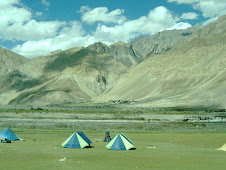
Informations about ladakh
Area: 97,000 sq kms out of which nearly 38,000 sq. kms are under Chinese Occupation since 1962.
Population: Approx. 2.40 lakh in the 2 districts of Leh & Kargil.
Languages: Ladakhi including Balti / Purgi, Shina or Dardic, Urdu / Hindi.
Ethnic composition: Mongoloid/Tibetan, Dardic and assorted Indo-Aryan elements.
Altitude: Leh 3505 m, Kargil 2750 m
| Temperature: | Maximum | Minimum |
| Summer | 25oC | 8oC |
| Winter | (-) 5oC | (-) 20oC |
Blog Archive
Tuesday, February 3, 2009
shey palace:- the old capital of ladakh
The famous pashmina (better known as cashmere) also came down from the high-altitude plateaux of eastern Ladakh and western Tibet, through Leh, to Srinagar, where skilled artisans transformed it into shawls known the world over for their softness and warmth. Ironically, it was this lucrative trade that finally spelt the doom of the independent kingdom. It attracted the covetous attention of Gulab Singh, the ruler of Jammu in the early 19th century, who sent his general Zorawar Singh to invade Ladakh in 1834 AD. There followed a decade of war and turmoil, which ended with the emergence of the British as the paramount power in north India. Ladakh, together with the neighbouring province of Baltistan, was incorporated into the newly created state of Jammu & Kashmir. Just over a century later, this union was disturbed by the partition of India, as a result of which Baltistan became part of Pakistan, while Ladakh remained in India as part of the State of Jammu & Kashmir.

Subscribe to:
Post Comments (Atom)






No comments:
Post a Comment